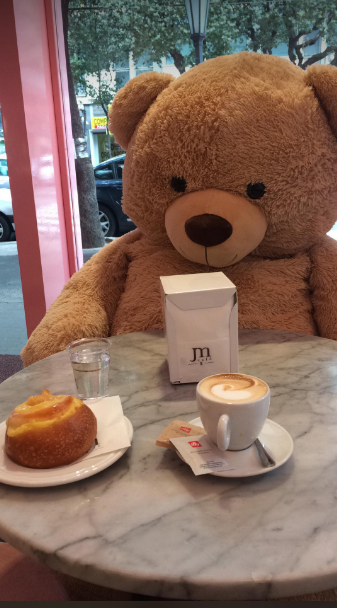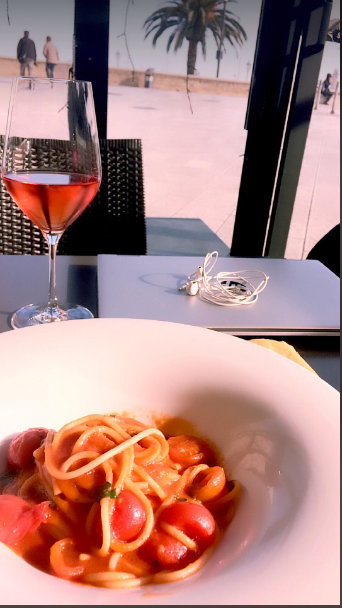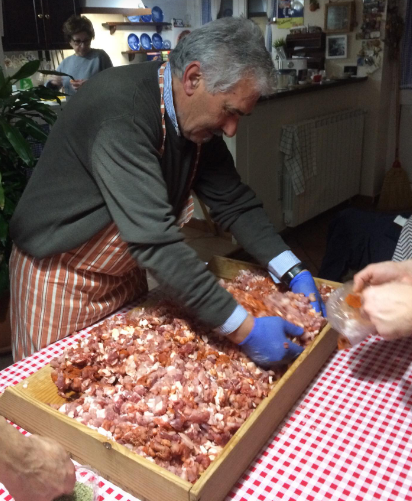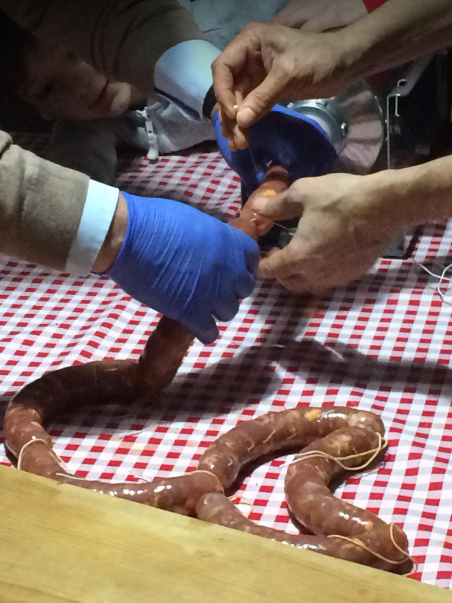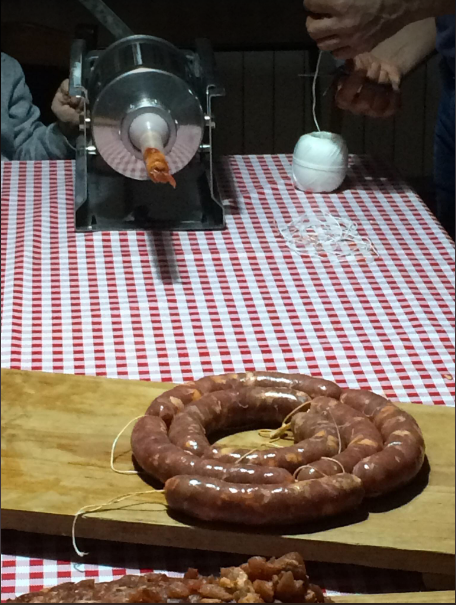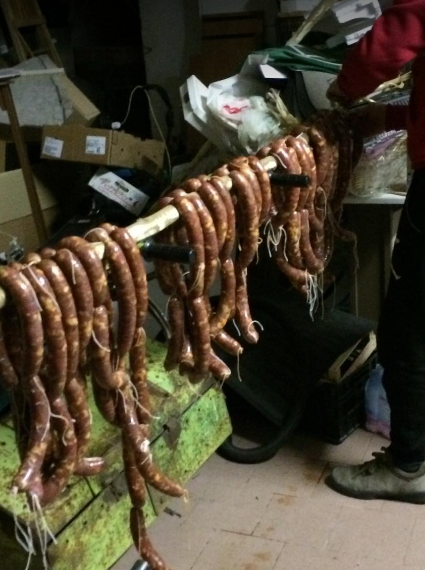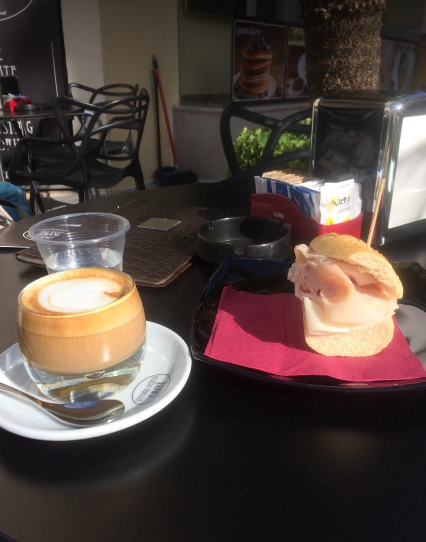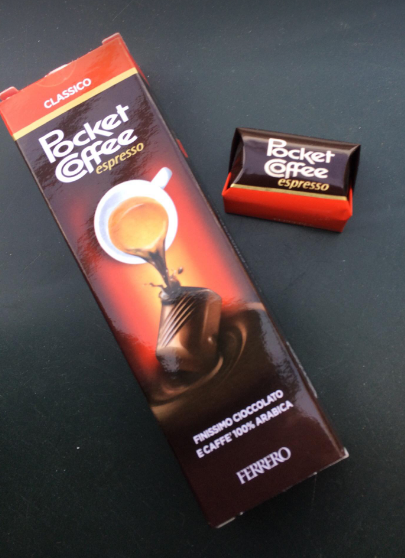Lusting after Italian pasta and coffee, and making sausages
Lusting after Italian pasta, dealing with a coffee drinking obsession, make sausages. and discovering local delicacies like horsemeat.
January-February 2020
I was trying to write up my stay in Montescaglioso in southern Italy. The history there is the stuff that feeds my imagination – secret tunnels, Benedictine monasteries of obscure origins, monks deliberately falsifying documents... But every time I started to write something I’d come back to the thing that Italy is really all about.
Food.
A country where food is important to everyone!
Right from my very first night there food was topical. I arrived quite late – not that this is a problem in Italy. After introductions they were worried about whether I would be ok with pizza for supper.
Of course I was. I love food, and I will try anything at least once.
I sat at the table feeling very awkward as they all waited for me. They all watched every movement I made. I glanced at each one of them – 5 pairs of eyes watching me. More than 24 hours on buses, and I was starving, so I looked back at the food. Perhaps it wasn’t pizza but focaccia which they made regularly, and I learnt is a very similar thing but for a few details. But they just wanted to know one thing.
How was I going to approach this pizza?
At last I did it the way I always have. I ignored the knife and fork and took a piece with my hand and started eating.
The whole table relaxed. The chatter started up. It seemed I had passed some sort of a test. Oh – and the pizza-focaccia was excellent.
The food was a constant. But this is Italy, so that is to be expected. The very next day the son who was studying medicine in Sardinia came home. His gift to the house was….
Bread.
At the dinner table he brought out his bread. This resulted in a family discussion, in which everyone actively participated, including the men. The discussion must have lasted for a solid ten minutes.
Ten minutes might not seem an extensive discussion. But everything I have to say about bread I’d probably be out of talk in closer to 10 seconds.
They broke the bread in half, discussed its texture and qualities, brought out another loaf to compare which was the superior bread, also breaking it in half to examine the insides, followed with heated discussions until a conclusion was reached.
And that was just for one loaf of bread.
The attitude to food is part of everyone – not just the women, not just the men, but something from a very young age. I had a class of 8-year-old beginners to work with, who happened to be learning about food. I presented some food flashcards, then worked on a game of charades for ‘guess that food’.
Anywhere else I have taught, the picture for fish would have resulted in mimicking the way a fish swims in the water. Maybe some puffing out of the cheeks and a bit of breaststroke. But in this class they did nothing of the sort. They mimicked how to prepare the fish for dinner.
They may have been only 8, but they were Italians 8-year-olds.
The meals were a constant problem for me. I mean, I’ve been through so many different eating patterns in some ways I’ve no idea what suits my body. Following a period of very erratic eating – everything from too often eating food bad for me to nothing decent for 24 hours, meals at all hours, and others interrupted so that in spite of being starving and food ready I’d have to put it on hold for a couple of hours.
Then while using up a lot of energy walking 20km a day as a meter reader I found that the best for me was a nibble every time I got hungry – half a sandwich while on the march. At that point I was getting up at 4:30 am for breakfast. After that I started teaching and wasn’t home til after 9, with dinner to come after that. And in a completely different time zone.
Nevertheless, the Italian meals were a challenge for me. Breakfast was light and small – coffee and a croissant or two. Then it was a long way to lunch – it is simply not respectable to eat before at least 2pm.
And the meals were massive.
This was a pasta in Bari. But the homecooking was easily as good.
An entrée of salad or soup perhaps, a plate of (to die for – every.single.time) pasta which was always served in a sauce which had been simmering for a good couple of hours, usually starting with a rue of chicken bones. Then the ‘main’ meal – cold salad with the hot meat and vegetables used for the rue – a combination that worked remarkably well, and all eaten with bread. Followed by fruit and coffee. Properly percolated of course.
That was the main meal of the day. And every single day was pasta. I never tired of it. Something about it cooked properly – al dente, in case anyone doesn’t know, means barely cooked to the point that it’s almost not cooked properly at all. And then it is mana from heaven. A shade more and it becomes ordinary. Another shade and it’s not even a food worth eating.
So from that point of being completely stuffed it would be another interminable wait – dinner, or supper, was never before 9pm. That just wasn’t respectable.
Almost everything they ate was grown on their own farm, or swapped from somebody who had grown it. They bought pasta and anything else they didn’t have from locally made sources. I wasn’t there for the tomato season, but they had endless jars of tomatoes cooked up and ready for use as passata – a year’s supply. And of olives. And olive oil. You name it – the small room at the back of the garage contained quite an impressive store of various preserved foods. It will be the southern Italians who will outlast the zombie apocalypse!
Some of the more interesting delicacies included preserved pork fat. They sliced it thinly for a biscuit or some bread. To me it tasted like… a thin slice of fat. Maybe that one was more of an acquired taste.
Another, also homemade, and this was one I loved – was limoncello – the lemon flavoured liqueur. Yum!
And then there was sausage making – those preserved sausages we buy under names like salami and pepperoni which are made and eaten throughout Europe.
Step two, mixing in the spices - after we had all sat around for the afternoon chopping up the meat.
The process starts with a huge quantity of raw pork, which is chopped up into mouth sized chunks. This is then mixed with spices and left to marinate for a day. The men took care of this part. The rest of us socialized over some snacks, coffee and homemade wine and limoncello. Because food is always a family event.
The intestines being readied to slip over the nozzle.
Was it a day or two later for the sausage making. The sausage machine was produced, and then in teams they proceeded to turn the meat into sausages. A large supply of washed and cleaned intestines had already been purchased. One fed the intestines onto the machine, another the meat into the other end, and a third turned the handle to process it, while another (that’s where I jumped in) cradled the resulting sausage and tied the end with string when it was long enough.
Tying the sausages off with string.
Again, except for me, the men took care of this part. The women supplied the food and chatter.
A Catherine wheel of sausage, anybody?
These long sausages were then hung over a stick and left in the garage to dry out.
For 2 weeks.
Until there was a nice film of mould covering them.
This was dealt with by rubbing them with olive oil. I liked to think that this removed the mould from the sausage, but I know I was just fooling myself to say so.
You’ve heard of the spaghetti tree? Well this one’s the sausage tree.
Another little gadget was produced and the mouldy-olive oil wiped sausages were vacuum-seal packed for storage, the packages distributed around the various households who were part of this one. Again, all this was done by the men.
At some point while I was in Montescaglioso someone was saying to me how disgusting they thought Chinese food. Having spent a lot of time living in China, cooking my own, and loving Chinese food (real Chinese food, not restaurant Chinese food), I frowned at them. I thought of the slices of pure pork fat and the sausage making process. It is so much a matter of perspective what is considered “disgusting”.
For myself, that sausage was some of the best I have ever eaten.
As another treat I was taken for another local delicacy – in that part of Italy it is still normal to eat horse meat. If you know where to go there are some very ordinary looking shops which are the horse meat restaurants and serve up both cooked and raw dishes.
A conversation about food in Italy is never complete without bringing up coffee. I may have some new amazing coffee discoveries to make, and have certainly appreciated different coffee types in different places. But so far the best of all countries is Italian coffee. It had a rich beautiful flavour that eclipses anywhere else I’ve been.
I’ve been a cappuccino drinker for a long time, so perhaps not surprisingly my coffee choice was the Italian half sized version of a cappuccino – called an espressino in the south (marocchino in the north). It had the same amount of coffee flavour packed into a half sized cup – so effectively double the strength and flavour. A burst of flavour. I even discovered that I could drink coffee black – I guess when the quality is good enough the milk isn’t necessarily needed for it.
But there was one last treat. The real secret they don’t tell you – come closer and I’ll share it with you.
Has to be included as one of the best inventions ever!
Shh - don’t tell anyone, but you can buy coffee shots wrapped up in dark chocolate. They call them Pocket Coffee. And very quickly became my biggest vice in Italy. Trust the Italians to come up with coffee in your pocket. I mean – shear brilliance. If a coffee shop is unavailable, you don’t have to forgo that needed shot! It became as important a part of my daily routine as all the other coffees. I’d head off to the English school at 4 in the afternoon, via the little shop where I could buy my packet of emergency coffee shots.
There are some countries which have amazing cuisines. I’m happy to agree that Italy is one of them.
